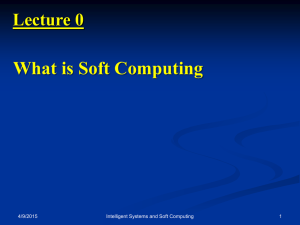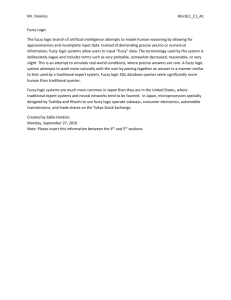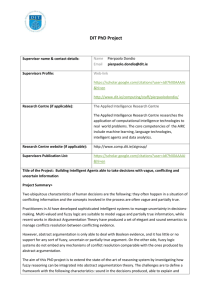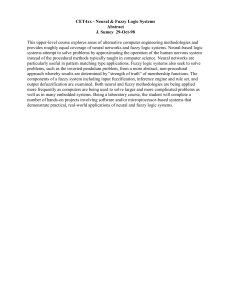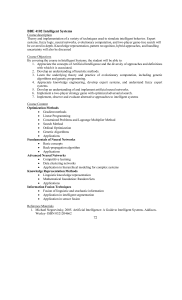The Simplified Action of Intelligent Fuzzy Control For A
advertisement
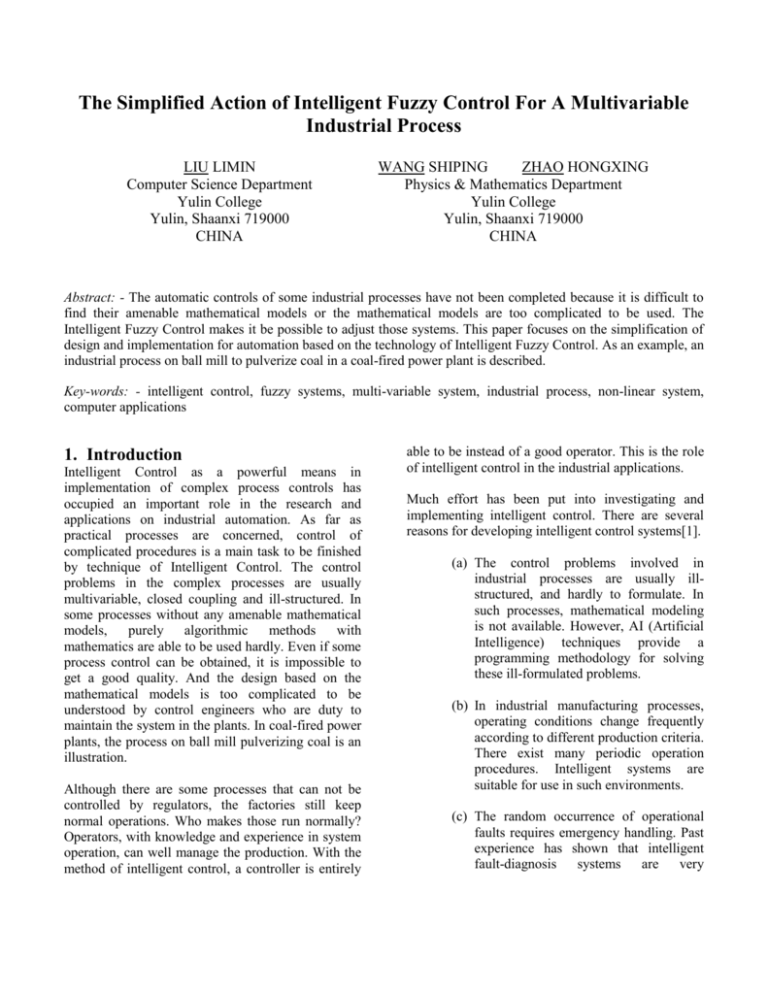
The Simplified Action of Intelligent Fuzzy Control For A Multivariable Industrial Process LIU LIMIN Computer Science Department Yulin College Yulin, Shaanxi 719000 CHINA WANG SHIPING ZHAO HONGXING Physics & Mathematics Department Yulin College Yulin, Shaanxi 719000 CHINA Abstract: - The automatic controls of some industrial processes have not been completed because it is difficult to find their amenable mathematical models or the mathematical models are too complicated to be used. The Intelligent Fuzzy Control makes it be possible to adjust those systems. This paper focuses on the simplification of design and implementation for automation based on the technology of Intelligent Fuzzy Control. As an example, an industrial process on ball mill to pulverize coal in a coal-fired power plant is described. Key-words: - intelligent control, fuzzy systems, multi-variable system, industrial process, non-linear system, computer applications 1. Introduction Intelligent Control as a powerful means in implementation of complex process controls has occupied an important role in the research and applications on industrial automation. As far as practical processes are concerned, control of complicated procedures is a main task to be finished by technique of Intelligent Control. The control problems in the complex processes are usually multivariable, closed coupling and ill-structured. In some processes without any amenable mathematical models, purely algorithmic methods with mathematics are able to be used hardly. Even if some process control can be obtained, it is impossible to get a good quality. And the design based on the mathematical models is too complicated to be understood by control engineers who are duty to maintain the system in the plants. In coal-fired power plants, the process on ball mill pulverizing coal is an illustration. Although there are some processes that can not be controlled by regulators, the factories still keep normal operations. Who makes those run normally? Operators, with knowledge and experience in system operation, can well manage the production. With the method of intelligent control, a controller is entirely able to be instead of a good operator. This is the role of intelligent control in the industrial applications. Much effort has been put into investigating and implementing intelligent control. There are several reasons for developing intelligent control systems[1]. (a) The control problems involved in industrial processes are usually illstructured, and hardly to formulate. In such processes, mathematical modeling is not available. However, AI (Artificial Intelligence) techniques provide a programming methodology for solving these ill-formulated problems. (b) In industrial manufacturing processes, operating conditions change frequently according to different production criteria. There exist many periodic operation procedures. Intelligent systems are suitable for use in such environments. (c) The random occurrence of operational faults requires emergency handling. Past experience has shown that intelligent fault-diagnosis systems are very powerful in dealing with such complex situations. (d) Industrial process control always deals with uncertain and fuzzy information. Conventional control systems fail to handle such information. However, intelligent control systems can process imprecise information. The system description in frequency domain is as follows. Y1 ( s) G11(s) G12 (s) G13 (s) X 1 (s) Y ( s) = G (s) G (s) G (s) X (s) (2.1) 22 23 2 21 2 Y3 ( s) G31(s) G32 (s) G33 (s) X 3 (s) where Gij(s)= Yi(s)/ Xj(s)= 3 Control problems concerned with about (a) and (d) will be discussed in following words. Fuzzy control, neural network and knowledge-based system are three main branches of intelligent control system. The idea of Fuzzy System was first applied to control system in 1974[2]. Since that time, there have been a lot of successful applications based on fuzzy systems. In resent years, more application systems are developed in fuzzy intelligent and neuro-fuzzy techniques[3] [4] [5]. This paper focuses on the simplified action of intelligent fuzzy control for complex industrial processes. 2. The Simplified Action of Intelligent Fuzzy Control A complex industrial process often deals with the problems of multivariable control in which there are more than two controlled variables and acting variables in a system, or to be called as Multiple Input and Multiple Output (MIMO) systems. An important problem to be attended to is coupling. The coupling means that changing one acting variable has to concern with several controlled variables. And, the control of closed-loop system may be quite difficult. In order to solve the problem, decoupling algorithm and intelligent control techniques are useful. ( Ak s Ck ) [ k 1 3 (B s D ) ] k 1 (2.2) k k 1 In equation (2.2), Ak, Bk, Ck, Dk are coefficients of 3rd order functions in s variable. Decoupling is to find a matrix D(s), and to make G(s)D(s) into G *(s) that is a diagonal matrix[6]. That is 0 0 G11 ( s) G*(s)= G22 ( s) 0 0 0 0 G33 ( s) = G(s)D(s) (2.3) And D(s)= G 1 (s) G*(s) (2.4) 1 * Where G (s)= G’(s)/|G (s)| D(s) is a decoupling matrix of (2.1). X1 G11 G21 G31 X2 G12 G22 G32 Y2 X3 G13 G23 G33 Y3 Y1 Xj, j=1,2,3, is acting variable. Yi, i=1,2,3, is controlled variable. 2.1 The Decoupling in Mathematics Here we focus on decoupling control as a typical method to solve multivariable problems. A reason to use the methodology is that decoupling can remove the linkage among related variables and separate a multivariable coupling loop into several single-loop systems. On theory, the way is a path to solve all of multivariable coupling problems. But, in fact, that is impossible. Here is a multivariable system, for instance, with three acting variables and three controlled variables in Fig.2.1. Fig.2.1 Relationship of acting variables and controlled variables To get the D(s) in (2.4), we have to solve a ninth order reverse matrix. For an industrial process, it is too complicated to utilize. Therefore, the method is not practicable for a plant. There are several other decoupling methodologies, such as feed-forward and unit-matrix algorithms, based mathematics, but they are almost not good for complex industrial processes. The complicated structure and special controllers for those algorithms are not easy and convenient in systems testing, trial running, maintaining and improving. should be adjusted. The adjusting is made by reasoning which is taken place by an expert system with fuzzy rule sets. fuzzification What way is suitable to solve the multivariable coupling problems in the plants? Research and test show that intelligent fuzzy control is able to envisage the challenge. measure 2.2 Intelligent Fuzzy Control and Simplification Intelligent fuzzy control actually is a kind of imitation control. Every process, whether simple or complex, in plants can run normally. It is not too much to say that person is a universal controller. Of course, there is various control quality , some better, others worse, by different operators. With rapidly growing of computer science and control technology, it is entirely possible that machines are used instead of people to adjust the complex systems. Actually, machines may do better than human sometimes. Intelligent control solves industrial problems through various paths, like to handle knowledge and experience by expert systems, to express uncertain and imprecise information by fuzzy set, to learn and modify rules of control by neural networks. For an industrial application, the model based on knowledge is relatively simpler than its mathematical model. The establishment of knowledge model has to depend on practical knowledge and experience of excellent operators. The knowledge model is composed of fuzzy rule sets in fuzzy control system. The intelligent fuzzy control is an extension of fuzzy control. Their block expressions are illustrated as Fig.2.2(a) and (b). The difference between them is that the fuzzy control table in Fig.2.2 (a) is replaced by two blocks, analyzing & inferring and evaluating & deciding in Fig.2.2 (b). Intelligent fuzzy control is different from fuzzy control based on the stationary control table. It applies trace and prevision control of dynamic characteristic to the procedures. The analyzing in block of analyzing & inferring for intelligent fuzzy control is to analyze operation state of the system, then judge whether its acting variables Fuzzy control table defuzzification Industrial process execute (a) Fuzzy Control System analyzing & inferring evaluating & deciding fuzzification measure defuzzification Industrial process execute (b) Intelligent Fuzzy Control System Fig.2.2 Blocks of Fuzzy Control and Intelligent Fuzzy Control Generally, forward rule based inference (F rule inference) is used because it is the reasoning from facts to results. The inferring conforms to the regularity of industrial control. In practical productions, operators manage the systems always to refer to facts, such as the change of measuring signals, collected from the processes to make decision. The decision in a controller is the task of evaluating & deciding block. The evaluating in block implies to analyze the inferring results and to judge whether they should be passed to the deciding model. Since industrial processes are conditional and continuous systems, variations of parameters are limited in the special ranges. Therefore, the reasoning in an intelligent fuzzy controller is simpler than a normal expert system. The implementation of the controller is easier. It can be fulfilled by a microcontroller. An intelligent fuzzy controller is built on the multi-level rules and multiple rule sets. The multi-level rules are shown like: IF <process state> THEN <intermediate variable 1> IF < intermediate variable 1> THEN <intermediate variable 2> … c. Sub-atmospheric Pressure to be controlled Recycle Air. With closed coupling among the three loops, the scheme is not successful. The automatic control systems can not be used. 5 1 IF < intermediate variable n> THEN <control action>. The multiple rule sets are as: 4 FC 2 HA Basic Rule Set, High Level Rule Set, Tuning Decision Rule Set, Adapting System Rule Set, …. They are designed in different cases. RA P 1 2 3 3. An Example: Ball Mill Pulverizing Coal System Ball mill pulverizing coal systems are the most pulverizing systems used at coal-fired power plants in China. The pulverizing systems make raw coal into powder that has dryness and fineness requested and is blown into boilers for firing. From the Fig.3.1, the procedure of pulverizing coal is that raw coal from bucket through feeder is mixed with hot and recycle air, then enters ball mill to be grounded, is made powder to output into separator. In separator, the certified powder is conveyed to the bank, others return the mill. If the ball mill run in the rated output, the operation is most efficient and obtains better benefit. 3.1 Traditional Design The traditional control systems for ball mill are designed as three single loop systems which are: a. Pressure Difference to be controlled Feed Coal; b. Temperature to be controlled Hot Air; 3 4 5 P T Raw Coal Bucket Coal Feeder Ball Mill Separator Powder Bank Acting Variables: FC: amount of Feed Coal HA: Hot Air RA: Recycle Air Controlled variables: P : entry sub-atmospheric Pressure P: pressure difference (for load) T : outlet Temperature Fig.3.1 Sketch of Ball Mill Pulverizing Coal System A decoupling method with diagonal matrix is feasible in theory. The transfer functions are given as follows. G11(s)=T(s)/m1(s) =0.94/(80s+1)3 G21(s)=P(s)/m1(s) =1.6/(8s+1) G31(s)=P(s)/m1(s)=-0.02 G12(s)=T(s)/m2(s) =0.17/[(60s+1)3(45s+1)] G22(s)=P(s)/m2(s) =0.54/(11s+1) G32(s)=P(s)/m2(s)=0.44/[(11s+1)(8s+1] G13(s)=T(s)/m3(s) G23(s)=P(s)/m3(s) =1/770s(80s+1) =0.1e-240s/(250s+1) G33(s)=P(s)/m3(s)=1/[1425s(80s+1)] where T(s) represents Temperature, P(s) for Sub-atmospheric Pressure and P(s) for Pressure Difference; m1(s), m2(s) and m3(s) separately stand for Hot Air, Recycle Air and Feed Coal. T ( s) m1 ( s ) When C(s)= P( s) M(s)= m2 ( s ) P( s) m3 ( s ) G11 ( s) G12 ( s) G31 ( s) G(s)= G21 ( s) G22 ( s) G32 ( s) G31 ( s) G32 ( s) G33 ( s) Then Positive Very large Positive Large Positive Medial Positive Small ZerO Negative Small Negative Medial Negative Large Negative Very large The rules suited to F rule inference can be set. They are expressed as follows. Rule 1 IF THEN AND AND Pressure Difference is PL Feed Coal adjusts in NL Hot Air adjusts in NS Recycle Air adjusts in NS Rule 2 IF THEN AND AND Pressure Difference is NL Feed Coal adjusts in PL Hot Air adjusts in PS Recycle Air adjusts in PS C(s)=G(s)M(s) 0 0 G11 ( s) * If to get G (s)= G22 ( s) 0 0 0 0 G33 ( s) And PV PL PM PS ZO NS NM NL NV G(s)D(s)= G*(s) We can obtain the decoupling matrix D(s) from D(s)= G-1(s) G*(s) where G-1(s) is an inverse matrix on G(s). To solve a ninth order matrix is not easy. Even if the solution is able to be found in theory, it is not available for the practical applications. At least two problems may have to make the control harder by the mathematical methods. First, a lot of steel balls filled in the pulverizing equipment will affect the dynamic characteristic of the system when the numbers of balls and wear-and-tear are varied. In the other hand, the humidity and quality of raw coal also influence the process control. 3.2 Intelligent Fuzzy Control for Ball Mill[7] In fact, operators do not make so complicated calculation and still manage the system better. This shows that the system can be controlled by nonmathematics way. Based the imitated control, intelligent fuzzy controller for the ball mill can be designed. In this case, deviation of variables are quantized into nine fuzzy levels as: Rule 3 IF Pressure Difference is PS THEN Feed Coal adjusts in NS Rule 4 IF Pressure Difference is NS THEN Feed Coal adjusts in PS … Although there are a lot of rules from excellent operators, not all of them are available for an application. Since sampling period of controller is not longer than 50 ms, it is almost impossible that the controlled variables of the system occur PL or NL in the twinkling. Hence, rules dealt with NS or PS, like Rule 3 and Rule 4, are generally inquired for by the inferring engine in the controller. In practical cases, Hot Air and Recycle Air are not often adjusted. The main controlled variable is Pressure Difference. Correspondingly, acting variable Feed Coal is an important role in the control system. According to the experience of the operators, the control of Feed Coal depends on not only Pressure Difference but also the status of the coal and mill. Congestion in the entry of a ball mill is a frequent trouble in operation. It can be described by a rule as: IF AND AND THEN Pressure Difference is PL or PVL Temperature is PL or NL Sub-atmospheric Pressure is NL congestion warning . initialisation models. It is suitable to the practical applications that are requested to operate simply, maintain conveniently and modify easily. Intelligent fuzzy control is able to simplify the control implementation for some complex processes through logic and inferring way under rule sets. However, the simplification for industrial applications normally means reliable and available. measurement data handle No need to adjust ? Yes fuzzification warning or advising Yes mill with any trouble? No inference and analysis decision defuzzification execution Fig.3.2 The Operating Flow Block of Intelligent Fuzzy Controller for Ball Mill Other rules for warning or advising have to be designed. The operating flow block of intelligent fuzzy controller for ball mill is given as Fig.3.2 . The implementation of the controller is not difficult. Its core is built on a micro-controller MCS51. MCS51 assembly is the programming language. The result of practical operation shows that the control scheme is feasible. 4. Conclusions Since intelligent fuzzy control, a branch of intelligent control, does not depend on the mathematical model, it is to accomplish the automatic regulation for some industrial processes described without mathematical models or with too complicated mathematical References: [1] M.Rao, “Frontiers and challenges of intelligent process control”, Engineering Applications of Artificial Intelligence, Vol. 5, No. 6, pp.475-481, 1992. [2] E.H.Mamdani and S.Assilian, “A case study on the application of fuzzy set to automatic control”, Proceedings IFAC Stochastic Control Symposium, Budapest, Hungary, 1974. [3] J.J.Henry, J.L.Farges and J.L.Gallego, “Neuro-fuzzy techniques for traffic control”, Control Engineering Practice, Vol. 6, No. 6, pp.755-761, 1998. [4] B.J.LaMeres and M.H.Nehrir, “Fuzzy logic based voltage controller for a synchronous generator”, IEEE Computer Applications in Power, Vol. 12, No. 2, pp.46-49, 1999. [5] N.H.C.Yung and C.Ye, “Intelligent mobile vehicle navigator based on fuzzy logic and reinforcement learning”, IEEE Transaction on System, Man and Cybernetics, Vol. 29, No. 2, pp.314-321, 1999. [6] Y. Jing, “Process control”, Tsing Hua University Publish, Beijing, China, pp.171-179, 1993. [7] L.Liu, “A computer expert control for the ball mill pulverizer”, Proceedings of The 2nd International Conference on Measurement and Control of Granular Materials, Chengde, China, pp.158-160, 1991.

